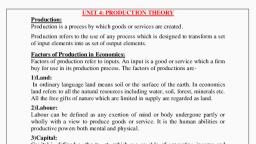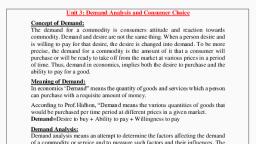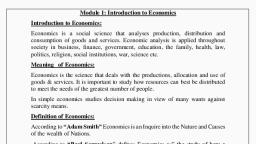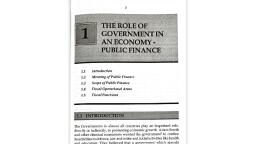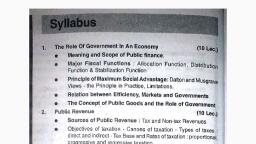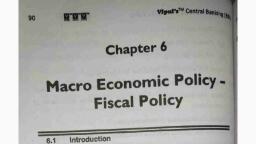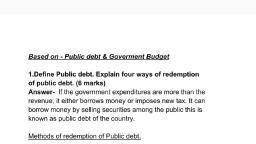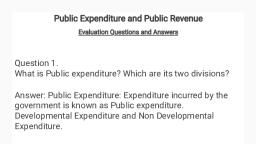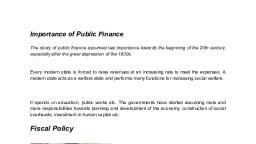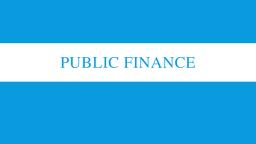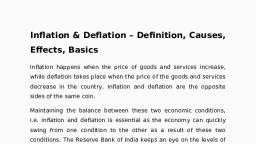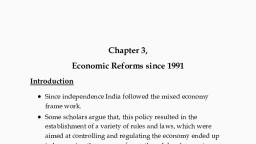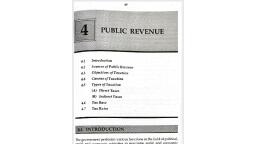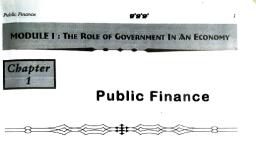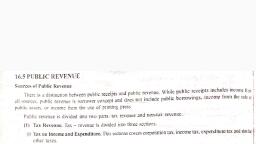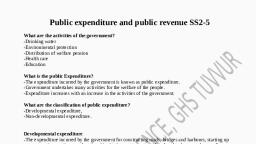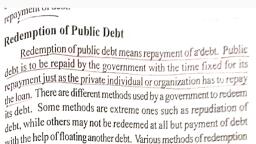Page 1 :
Chapter 2:, , Public Financial Policy, Public finance is the study of the role of the government in the economy. It is the branch of, economics that assesses the government revenue and government expenditure of the public, authorities and the adjustment of one or the other to achieve desirable effects and avoid, undesirable ones., , There are four branches of public finance:• public expenditure, • public revenue, • public debt and, • financial admininistration, Public Expenditure, we study the various principles, effects and problems of expenditure made by, the public authorities., Public Revenue, we study the various ways of raising revenues by the public bodies. We also study, the principles and effects of taxation and how the burden of taxation is distributed among the, various classes in the society, , Public Debt is the study of the various principles and methods of raising debts and their, economic effects. It also deals with the methods of repayment and management of public, debt., Financial Administration deals with the methods of budget preparation, various types of, budgets, war finance, development finance, etc, , The principle of Maximum social advantage, The principle of Maximum social advantage is the ‘Principle of Public Finance’. It is the fundamental, principle which should determine fiscal operations of the government. This principle is formulated, and popularized by Dr. Dalton and Prof. Pigou. Dr. Dalton calls it as the principle of maximum social, advantage and Prof. Pigou describe as principle of Maximum Aggregate Welfare. The principle, provides guidance to the Govt. regarding public revenue and public expenditure or public finance, operations so as to maximise social advantage or welfare. According to Dalton, the principle of, maximum social advantage is the most fundamental principle lying at the root of public finance., Hence, the best system of public finance is that which secures the maximum social advantage from, its fiscal operations. Maximum social advantage is the maxim for the states. The optimum financial, activities of a state should, therefore, be determined by the principle of maximum social advantage., It is obvious that taxation by itself is a loss of utility to the people, while public expenditure by itself, is a gain of utility to the community. When the state imposes taxes, some disutility or dissatisfaction, is experienced in the society. This disutility is in the form of sacrifice involved in the payment of, taxes — in parting with the purchasing power. As such, the maximum social advantage is achieved, when the state in its financial activities maximise the surplus of social gain or utility (resulting from, public expenditure) over the social sacrifice or disutility (involved in payment of taxes.) The principle, of maximum social advantage implies that public expenditure is subject to diminishing marginal, social benefits and taxes are subject to increasing marginal social costs. So it is necessary to get an, equilibrium position where marginal social benefits of public expenditures are equal to the marginal, social sacrifice of taxation to maximize social advantage. According to Dalton “Public expenditure in
Page 2 :
every direction should be carried just so far, that the advantages to the community of a further small, increase in any direction is just counter-balanced by the disadvantage of a corresponding small, increase in taxation or in receipts from any other sources of public expenditure and public income.”, According to Hugh Dalton, "The best system of public finance is that which secures the maximum, social advantage from the operations which it conducts.", This principle is however based on the following assumptions:, 1. All taxes result in sacrifice and all public expenditures lead to benefits., 2. Public revenue consists of only taxes and no other sources of income to the government., 3. The government has no surplus or deficit budget but only balanced budget., 4. Public expenditure is subject to diminishing marginal social benefit and taxes are subject to, increasing marginal social sacrifice., , Marginal Social Sacrifice (MSS):, Marginal Social Sacrifice (MSS) refers to that amount of social sacrifice undergone by public due to, the imposition of an additional unit of tax. Every unit of tax imposed by the government taxes result, in loss of utility. Dalton says that the additional burden (marginal sacrifice) resulting from additional, units of taxation goes on increasing i.e. the total social sacrifice increases at an increasing rate. This, is because, when taxes are imposed, the stock of money with the community diminishes., , Marginal Social Benefit (MSB):, While imposition of tax puts burden on the people, public expenditure confers benefits. The benefit, conferred on the society, by an additional unit of public expenditure is known as Marginal Social, Benefit (MSB). Just as the marginal utility from a commodity to a consumer declines as more and, more units of the commodity are made available to him, the social benefit from each additional unit, of public expenditure declines as more and more units of public expenditure are spent., The Point of Maximum Social Advantage:, Social advantage is maximised at the point where marginal social sacrifice cuts the marginal social, benefits curve. In the diagram, the marginal disutility or social sacrifice is equal to the marginal utility, or social benefit at the point P. Beyond this point, the marginal disutility or social sacrifice will be, higher, and the marginal utility or social benefit will be lower, , At point P social advantage is maximum. If we consider Point P1, at this point marginal social benefit, is P1Q1. This is greater than marginal social sacrifice S1Q1. Since the marginal social sacrifice is lower, than the marginal social benefit, it makes more sense to increase the level of taxation and public
Page 3 :
expenditure. This is due to the reason that additional unit of revenue raised and spent by the, government leads to increase in the net social advantage. This situation of increasing taxation and, public expenditure continues, as long as the levels of taxation and expenditure are towards the left, of the point P. At point P, the units of taxation and public expenditure moves up to OQ, the marginal, utility or social benefit becomes equal to marginal disutility or social sacrifice at this point. Therefore, at this point, the maximum social advantage is achieved. If we moved forward to OQ levels of units,, the marginal social sacrifice S2Q2 is greater than marginal social benefit P2Q2. Therefore, beyond, the point P, any further increase in the level of taxation and public expenditure may bring down the, social advantage. This is because; each subsequent unit of additional taxation will increase the, marginal disutility or social sacrifice, which will be more than marginal utility or social benefit. This, shows that maximum social advantage is attained only at point P & this is the point where marginal, social benefit of public expenditure is equal to the marginal social sacrifice of taxation., , Types of public expenditure:, 1. Capital and Revenue Expenditure:, Capital Expenditure of the government refers to that expenditure which results in creation of fixed, assets. They are in the form of investment. They add to the net productive assets of the economy., Capital Expenditure is also known as development expenditure as it increases the productive, capacity of the economy. It is an investment expenditure and a non-recurring type of expenditure., For Eg. Expenditure – on agricultural and industrial development, irrigation dams, public -enterprises, etc, are all capital expenditures, Revenue expenditures are current or consumption expenditures incurred on civil administration,, defence forces, public health and , education, maintenance of government machinery etc. This type, of “expenditure is of recurrent type which is incurred year after year., , 2. Development and Non – Developmental Expenditure:, Expenditure on infrastructure development, public enterprises or development of agriculture, increase productive capacity in the economy and bring income to the government. Thus they are, classified as productive expenditure. All expenditures that promote economic growth development, are termed as development expenditure., Unproductive (non – development) expenditure refers to those expenditures which do not yield any, income. Expenditure such as interest payments, expenditure on law and order, public, administration, do not create any productive asset which brings income to government such, expenses are classified as unproductive expenditures., , 3. Transfer and Non – Transfer Expenditure :, Transfer expenditure refers to those kind of expenditures against there is no corresponding transfer, of real resources i.e., goods or services. Such expenditure includes public expenditure on :- National, Old pension Scheme, Interest payments, subsidies, unemployment allowances, welfare benefits to, weaker sections etc. By incurring such expenditure, the government does not get anything in return,, but it addsto the welfare of the people, especially to weaker sections of society. Such expenditure, results in redistribution of money incomes within the society., The non – transfer expenditure relates to that expenditure which results in creation of income or, output The non – transfer expenditure includes development as well as non – development, expenditure that results in creation of output directly or indirectly. Economic infrastructure (Power,, Transport, Irrigation etc.), Social infrastructure (Education, Health and Family welfare), Internal law, and order and defence, public administration etc. By incurring such expenditure, government, creates a healthy environment for economic activities., , 4)Plan And Non – Plan Expenditure
Page 4 :
The plan expenditure is incurred on development activities outlined in ongoing five year plan. In, 2009-10, the plan expenditure of Central Government was 5.3% of GDP. Plan expenditure is incurred, on Transport, rural development, communication, agriculture, energy, social services, etc., The non – plan expenditure is incurred on those activities, which are not included in five-year plan. It, includes development and non – development expenditure. It includes :-Defence, subsidies, interest, payments, maintenance etc., , Sources of Public Revenue:, A] Tax Revenue:, Taxes are the first and foremost sources of public revenue. It is compulsory payments to the, government without expecting direct benefit or return by the taxpayer. Taxes collected by, Government are used to provide common benefits to all mostly in the form of public welfare, services. They do not guarantee any direct benefit for the person who pays the tax. It is not based on, a direct quid pro quo principle., , 1] Union Excise Duties:, They are, presently, by far the leading source of revenue for the Central Government and are levied, on commodities produced within the country, but excluding those commodities on which State, excise is levied (viz., liquors and narcotic drugs). The most important commodities from the revenue, point of view are sugar, cotton, mill cloth, tobacco, motor spirit, matches, and cement., , 2] Customs, Customs duties include both import and export duties. These are the second-most important source, of revenue for the Central Government., , 3] GST Tax:, GST is an indirect tax levied in India on the supply of goods and services. GST levies at every step in, the production process but is meant to refund to all parties in the various stages of production other, than the final consumer., , 4] Income Tax, Income tax is at present another important source of revenue for the Central Government. It levies, on the incomes of individuals, Hindu undivided families, and unregistered firms., , 5] Corporation Tax:, The income-tax on the net profits of joint-stock companies calls corporation tax., , 6] Wealth Tax:, It is an annual tax on the net wealth of individuals and Hindu undivided families. It is a progressive, tax., , 7] Gift Tax:, It is a tax on gifts of property by an individual in his lifetime to future successors., , 8] Capital Gains Tax:, It applies to capital gains resulting from the sale, exchange or transfer of capital assets., , 9] Hotel Expenditure Tax:, Recently, a new tax has been levied on those who patronize high-class hotels. Another new tax, levied on foreign travel for conserving foreign exchange as well as to raise revenue., , B] Non-Tax Revenue:, The revenue obtained by the government from sources other than the tax calls Non-Tax Revenue., Public income received through the administration, commercial enterprises, gifts, and grants is the, source of non-tax revenues of the government., , Administrative Revenues:
Page 5 :
Under public administration, public authorities can raise some funds in the form of fees, fines and, penalties, and special assessments., , Fees:, Fees are charged by the government or public authorities for rendering a service to the beneficiaries., To quote Seligman, “A fee is a payment to defray the cost of each recurring service undertaken by, the government, primarily in the public interest, but conferring a measurable advantage to the, payer.”, , Fines and Penalties:, Fines and penalties are levied and collected from offenders of laws as punishment. Here the main, object of these levies is not so much to earn an income as to prevent the commission of offences, and infringement of laws of the country. Fines and penalties are arbitrarily determined and have no, relation to the cost of administration or activities of the government. Hence, collections from such, levies are insignificant as a source of public revenue., , Meaning of Canons of Taxation:, By canons of taxation we simply mean the characteristics or qualities which a good tax system, should possess. In fact, canons of taxation are related to the administrative part of a tax., , Types of Canons of Taxation:, 1. Canon of Equality:, Canon of equality states that the burden of taxation must be distributed equally or equitably, among the taxpayers. However, this sort of equality robs of justice because not all taxpayers, have the same ability to pay taxes. Rich people are capable of paying more taxes than poor, people. Thus, justice demands that a person having greater ability to pay must pay large, taxes., , 2. Canon of Certainty:, The tax which an individual has to pay should be certain and not arbitrary. According to A., Smith, the time of payment, the manner of payment, the quantity to be paid, i.e., tax, liability, ought all to be clear and plain to the contributor and to everyone. Thus, canon of, certainty embraces a lot of things. It must be certain to the taxpayer as well as to the taxlevying authority., , 3. Canon of Economy:, This canon implies that the cost of collecting a tax should be as minimum as possible. Any, tax that involves high administrative cost and unusual delay in assessment and high, collection of taxes should be avoided altogether., , 4. Canon of Convenience:, Taxes should be levied and collected in such a manner that it provides the greatest, convenience not only to the taxpayer but also to the government., , 5. Canon of Simplicity:, Every tax must be simple and intelligible to the people so that the taxpayer is able to, calculate it without taking the help of tax consultants. A complex as well as a complicated, tax is bound to yield undesirable side-effects. It may encourage taxpayers to evade taxes if, the tax system is found to be complicated., , 6. Canon of Elasticity:, Modern economists attach great importance to the canon of elasticity. This canon implies, that a tax should be flexible or elastic in yield.
Page 6 :
7. Canon of Diversity:, Taxation must be dynamic. This means that a country’s tax structure ought to be dynamic or, diverse in nature rather than having a single or two taxes. Diversification in a tax structure, will demand involvement of the majority of the sectors of the population., , Direct tax:, A direct tax is a tax that a person or organization pays directly to the entity that imposed it., An individual taxpayer, for example, pays direct taxes to the government for various, purposes including income tax, real property tax, personal property tax, or taxes on assets., , Indirect tax:, An indirect tax (such as sales tax, per unit tax, value added tax (VAT), or goods and, services tax (GST), excise, consumption tax, tariff) is a tax that is levied upon goods and, services before they reach the customer who ultimately pays the indirect tax as a part of, market price of the good or service purchased., , Impact of tax, Taxation on goods, income or wealth influence economic behaviour and the distribution of, resources., For example, higher taxes on carbon emissions will increase cost for producers, reduce, demand and shift demand towards alternatives., Higher income tax can enable a redistribution of income within society, but may have an, impact on reducing the incentives to work and supply labour., Taxation can have an impact on many aspects of the economy, including:, Labour supply, Labour productivity, Economic growth, Inflation, Production and consumption of goods, Saving rates/consumption, Income distribution, Resource distribution, Levels of government spending, , Incidence of tax, In economics, tax incidence or tax burden is the effect of a particular tax on the distribution, of economic welfare. Economists distinguish between the entities who ultimately bear the, tax burden and those on whom tax is initially imposed. The tax burden measures the true, economic weight of the tax, measured by the difference between real incomes or utilities, before and after imposing the tax, taking into account how the tax leads prices to change, , Elasticity and tax incidence:, Compared to previous phenomena, elasticity of the demand and supply curve is an essential, feature that predicts how much the consumers and producers will be burdened in the, specific case of taxation. As a general rule, the steeper the demand curve and the flatter the
Page 7 :
supply curve, the more the consumers will bear the tax. The flatter the demand curve and, the steeper the supply curve, the more the producers will bear the tax., , Budget incidence:, In a closed economy model, the state uses the taxes it collects to buy goods or, pay transfers to households and businesses. Tax revenue is in line with government, spending. Consequently, not only tax payments should be taken into account in the analysis,, but also at the same time the gains of utility for the private sector associated with, government spending. That is called budget incidence. Budget incidence represents the, combined burden effects of government revenue and government spending. The, government budget constraint always applies when deriving them; all tax revenue covers, government purchases of goods or transfer payments., , Consumer and producer surplus:, The burden from taxation is not just the quantity of tax paid (directly or indirectly), but the, magnitude of the lost consumer surplus or producer surplus. The concepts are related but, different. For example, imposing a $1,000-per-gallon milk tax will raise no revenue (because, legal milk production will stop), but this tax will cause substantial economic harm (lost, consumer surplus and lost producer surplus). When examining tax incidence, it is the lost, consumer and producer surplus that is important., , Effects of Taxation on Production, 1. Effects on Ability to work:, Taxes reduce disposable income. As such, the buying capacity and consumption expenditure, are curtailed. These cause the standard of living to deteriorate. Consequently, efficiency and, ability to work is adversely affected., , 2. Effect on the Ability to Save:, All taxes always have an adverse effect on one’s saving capacity., Ability to save is adversely affected by taxation as taxes fall on income and saving is the, function of disposable income. As disposable income declines, savings tend to decline., , 3. Effect on Ability to Invest:, Ability to invest in the private sector evidently falls on account of the reduced saving ability, caused by the tax imposition. Hence, all taxes have the immediate effect of reducing the, amount of resources available for investment in the private sector., , Effects of taxation on consumption, A tax increases the price of the taxed good relative to the prices of untaxed or lower taxed, goods., , 1. Income Effect of taxation, The tax reduces the purchasing power or real income of taxpayer. It takes resources away, from the taxpayer and transfers them to the government. This is often referred to as the direct, burden of the tax., , 2. Substitution (or Price) Effect of taxation, The tax creates an incentive for the taxpayer to substitute less preferred but untaxed or, lower-taxed goods for the more-preferred taxed good. The loss in consumer utility from this, substitution is the excess burden (or welfare cost) of the tax., , 3. Effects of Taxation on Consumption during Inflation and Depression
Page 8 :
Taxation has different effects in times of inflation and depression. During the time of, inflation, the purchasing power of the people is reduced by a raise in the rates of existing, taxes or imposition of new taxes. This would control the consumption and therefore, help in, bringing up stability in prices., During the period of depression, taxation may be reduced. As the result of the reduction on direct, tax rates, the people will have more disposable income and higher purchasing power and a decrease, in indirect taxes leads to the reduction of selling prices. Both of them encourage the total, consumption of the people and thereby the economic activities are induced in the country., , 4. Regulatory Effect of Taxation on Consumption, Taxation may be used to regulate the production and consumption. Consumption can be, regulated by taxing the production and use of certain commodities., For example, the object of some taxes may be to reduce the consumption of certain harmful, commodities such as liquors, cigars etc., , Effects of Taxation on Distribution, An important objective of taxation in most of the welfare states is to reduce the inequalities of, income and wealth and to bring about an equal society. The effects of taxation on the distribution of, income and wealth among the different sections of the society, depends upon two important, factors. They are as below, , 1. Nature of Taxation, and, 2. Kinds of Taxes, How to Nature of Taxation influence Distribution?, The nature of taxation influences the distribution of tax among the different sections of the, society. It includes proportional regressive and progressive nature of taxation., , a. Effects of Regressive Taxation on Distribution, Under regressive taxation, the burden of taxation falls more heavily upon the poor than on the, rich. Regressive taxation may increase the inequalities on the distribution of income and, wealth. Hence, the burden of taxation is higher on the poor than on the rich. In effect, this, system widens the gap between the rich and the poor., , b. Effects of Proportional Taxation on Distribution, Under the proportional taxation, taxes are levied uniformly upon the rich and the poor. When, the tax rate remains the same, it creates inequalities between them. However, if there is any, increase in the income of these sections, the inequalities in distribution of income will also, increase. The burden of taxation falls more heavily upon the poor than on the rich., , c. Effects of Progressive Taxation on Distribution, Under the system of progressive taxation, the tax rates go up with the increase in the income., Thus, in this system, the inequalities in the income and wealth will be reduced., The major portion of the income and the wealth of the rich is taken away by way of higher, tax rates. Hence, the progressive tax system tends to reduce the inequalities in the, distribution of income and wealth., , How to Kinds of Taxes influence distribution?, The effects of taxation depend upon the kinds of taxes i.e. direct or indirect taxes., , a. Effects of Direct Taxes on Distribution, Direct taxes take the form of taxation on the income and property. It attempts to reduce the, income of the richer sections and transfers the income to the Government. The Government
Page 9 :
may use these resources to raise the standard of living of the poor. Therefore, all those, taxes, which fall heavily upon the higher income groups, can have favorable distributional, effects., , b. Effects of Indirect Taxes on Distribution, Indirect taxes are levied on commodities. They fall heavily on the lower and middle-income, groups who spend a large portion of their income on commodities. In such a situation,, indirect taxes have adverse distributional effects., However, indirect taxes may be made progressive if the necessaries are exempted from, taxation or levied on low tax rates, and luxuries are subjected to higher rates of taxes., , Recent policy changes in direct tax and indirect tax, Direct Tax, I. Changes in Income Tax Rate Slab for Individual, Finance Minister Nirmala Sitharaman introduced new slabs and reduced the tax rate for, different slabs for an individual income up to Rs 15 lakh per annum, if a taxpayer opts for, foregoing exemptions and deductions., The new tax regime will be optional and the taxpayers will be given the choice to either, remain in the old regime with exemptions and deductions or opt for the new reduced tax, rate without those exemptions., Under the proposal, people with an annual income of Rs 5 lakh to Rs 7.5 lakh will have to, pay a reduced tax rate of 10 percent; between Rs 7.5 lakh and Rs 10 lakh: 15 percent;, between Rs 10 lakh and 12.5 lakh: 20 percent; between Rs 12.5 lakh and 15 lakh: 25, percent; and above Rs 15 lakh: 30 percent., Taxable Income Slab, , Tax under Old Regime, , Tax under New Regime, , Upto 2.5 lacs, , Nil tax, , Nil Tax, , 2.5 lacs to 5 lacs, , Tax @ 5%, , Tax @ 5%, , 5 lacs to 7.5 lacs, , Tax @ 20%, , Tax @ 10%, , 7.5 lacs to 10 lacs, , Tax @ 20%, , Tax @ 15%, , 10 lacs to 12.5 lacs, , Tax @ 30%, , Tax @20%, , 12.5 lacs to 15 lacs, , Tax @ 30%, , Tax @25%, , Above 15 lacs, , Tax @ 30%, , Tax @ 30%, , The taxability of income upto 5 lacs is not clear right now. However as per PIB (Press, Information Bureau), income tax rate for taxable income between 2.5 lacs and 5 lacs will be, 5%. The new regime will be optional and the people can continue with old regime if they, desire so. There are about 100 tax exemptions and deductions under income tax act and 70, of them are being removed in the new simplified tax regime, while the remaining will be, reviewed and examined in due course., , II. Rate of Income tax for other than Individuals
Page 10 :
Tax on cooperative societies is proposed to be reduced from present rate of 30% to 22%, plus surcharge and cess with no exemption/deduction., It is also proposed to exempt these co-operative societies from Alternative Minimum Tax, (AMT) just like companies under the new tax regime are exempted from the Minimum, Alternate Tax (MAT)., In order to give boost to the manufacturing sector, new provisions were introduced in, September 2019 offering a concessional corporate tax rate of 15% to the newly, incorporated domestic companies in the manufacturing sector which start manufacturing by, 31st March, 2023., To boost power generation capacity, government has extended the new corporate tax, regime for new domestic companies engaged in the generation of electricity. New power, generation companies will have to pay just 15 per cent tax under the new corporate tax, regime. This will help is setting up of new power generation companies to meet the growing, energy needs of India., , III. Shift of DDT Burden from companies to Individuals, Budget 2020 proposes to make dividend income from shares taxable in the hands of the, recipient at the applicable slab rates and abolish the Dividend Distribution Tax, (DDT) hitherto levied on dividend income before distribution., All kinds of dividend income i.e. dividend income received from mutual funds and equity, shares will now be taxable in the hands of taxpayers. The dividend income which was, hitherto tax-exempt in the hands of taxpayers will now become fully taxable. This would, mean that the taxable income of the individuals will go up., Currently, DDT is paid by the companies before paying dividend to their shareholders., Therefore, Dividend paid to the shareholders of the company becomes tax-free in their, hands., , IV. Deferment of tax payment on ESOP to employees of start-ups, It has been proposed in Budget 2020 to defer tax deducted at source (TDS) or tax payment, on income earned from Employee Stock Option Plans (ESOPs) given to employees of startups. This means that employees of start-ups who are exercising their ESOPs may have to pay, tax at a later date., ESOP is a significant component of compensation for these employees. Currently, ESOPs are, taxable as perquisites at the time of exercise. This leads to cash-flow problem for the, employees who do not sell the shares immediately and continue to hold the same for the, long term. In order to give a boost to the start-up ecosystem, it is proposed to ease the, burden of taxation on the employees by deferring the tax payment by five years or till they, leave the company or when they sell their shares, whichever is earliest., , V. Extension of Tax holiday for Start-ups, An eligible start-up having turnover up to Rs 25 crore is allowed deduction of 100 per cent, of its the profits for three consecutive assessment years out of seven years if the total, turnover does not exceed Rs 25 crore rupees. In order to extend this benefit to larger startups, it is proposed to increase the turnover limit from existing Rs 25 crore to Rs 100 crore., Moreover, considering the fact that in the initial years, a start-up may not have adequate, profit to avail this deduction, it is proposed to extend the period of eligibility for claim of, deduction from the existing seven years to 10 years., , VI. Tax Amendment for MSME’s
Page 11 :
An unveiled measures is aimed by government at facilitating growth of the country’s micro,, small and medium enterprises including raising the turnover threshold for audit of their, accounts to Rs 5 crore and a scheme to provide subordinate debt to MSME entrepreneurs., “Currently, only businesses having a turnover of more than Rs 1 crore are required to get, their books of accounts audited by an accountant. In order to reduce compliance burden on, small retailers, traders, shopkeepers who comprise the MSME sector, I propose to raise by, five times the turnover threshold for audit from the existing rupees one crore to five crore,”, Finance Minister Nirmala Sitharaman said while presenting the Budget 2020-21. Further, in, order to boost less cash economy, I propose that the increased limit shall apply only to, those businesses which carry out less than 5% of their business transactions in cash., A scheme will be introduced to provide subordinate debt to MSME entrepreneurs. Besides,, the government has also asked the Reserve Bank to extend the debt restructuring window, for micro, small and medium enterprises by a year to March 31, 2021., , VII. 100% tax exemption to Sovereign Wealth Fund of foreign governments, In order to provide incentive to the investment by the Sovereign Wealth Fund of foreign, governments in the priority sectors, 100% tax exemption is proposed to be granted to their, interest, dividend and capital gains income in respect of investment made in infrastructure, and other notified sectors before 31st March, 2024 and with a minimum lock-in period of 3, years., , VIII. Widening and Deepening Of Tax Base, a) TDS on E-commerce transactions: In order to widen and deepen the tax net, it is proposed to, provide that e-commerce operator shall deduct TDS on all payments or credits to e-commerce, participants at the rate of 1% in PAN/Aadhaar cases and 5% in non-PAN/Aadhaar cases. In order to, provide relief to small businessman, it is proposed to provide exemption to an individual and HUF, who receives less than Rs. 5 lakh and furnishes PAN/Aadhaar., b) Enlarging the scope of TDS on interest: It is proposed to extend the TDS on interest paid by certain, large co-operative societies whose gross receipts exceeds fifty crore rupees during the last financial year., , c) Widening the scope of TCS:It is proposed to provide for tax collection at source (TCS) on, remittance under Liberalised Remittance Scheme of Reserve Bank of India exceeding seven lakh, rupees in a year and on sale of overseas tour package. Further, TCS is also proposed on sale of goods, in excess of fifty lakh rupee in a year by a seller whose turnover is more than 10 crore rupees., d) Limit on exemption of Employer’s contribution to certain funds :It is proposed to put an, upper cap of seven lakh and fifty thousand rupees in a year on tax exempt employer’s contribution, in recognized provident fund, superannuation fund and NPS in the accounts of an employee., , IX. Tax Amendment for Non-Residents, i. The period of concessional withholding rate of 5% under section 194 LC is extended for interest, payment to non-residents in respect of moneys borrowed and bonds issued upto 30thJune, 2023., ii. The period upto 30thJune, 2023 for lower rate of withholding of 5% under section 194 LD is, extended for interest payment to Foreign Portfolio Investors (FPI) and Qualified Foreign Investors, (QFI) in respect of bonds issued by Indian companies and government securities., iii. The concessional rate of withholding of 5% under section 194 LD is extended to the interest, payment made on the municipal bonds., iv. Withholding tax rate on the interest payment on the bonds listed on IFSC exchange is reduced, from 5% to 4%., , X. Other Tax Amendment, a) A new taxpayer charter is to be instituted to end tax harassment. The Income Tax Act will be, amended to allow faceless appeals against tax orders on lines of faceless assessment., b) A new direct tax dispute settlement scheme — Vivaad se Vishwaas scheme is launched to bring, down litigation in direct taxation scheme saying 4.83 lakh direct cases are pending in various
Page 12 :
appellate forums. Interest and penalty will be waived under this scheme for those who wish to pay, the disputed tax amount till March 31., c) In order to ease allotment of PAN, new process of instantly allotting the same through Aadhaar, will be brought as announced under budget, 2020., d) It is also announced under budget,2020 for extending by one year the date of approval of, affordable housing projects for availing tax holiday on profit earned by developers. Extension of, additional Rs 1.5 lakh tax benefit is also announced on interest paid on affordable housing loans to, March 2021., e) New National Policy on Official Statistics is proposed to improve data collection and dissemination, with the help of technology., f) Registration of charity institutions to be made completely electronic and donations is made to be, pre-filled in IT return form to claim exemptions for donation., g) Currently, while taxing income from capital gains, business profits and other sources in respect of, transactions in real estate, if the consideration value is less than circle rate by more than 5 percent,, the difference is counted as income both in the hands of the purchaser and seller. In order to, minimize hardship in real estate transaction and provide relief to the sector, it is proposed to, increase the limit of 5% to 10%., h) It is proposed to provide that the amalgamated public sector banks and insurance companies shall, be eligible to take the benefit of unabsorbed losses and depreciation of the amalgamating entities., i) It is proposed to provide that the amalgamated public sector banks and insurance companies shall, be eligible to take the benefit of unabsorbed losses and depreciation of the amalgamating entities., In order to encourage unlisted Infrastructure Investment Trust (InvIT) or a Real Estate Investment, Trust (REIT), it is proposed to extend the same taxation regime as available to listed InvITs and listed, REIT to unlisted REIT and InvIT., j) It is proposed to provide exemption to Indian Strategic Petroleum Reserves Limited (ISPRL) in, respect of income accruing or arising as a result of an arrangement for replenishment of crude oil, stored in its storage facility in pursuance to directions of the Central Government in this behalf, subject to the condition of replenishment of crude oil within three years., k) In order to reduce litigation, it is proposed to reduce rate for TDS in case of fees for technical, services (other than professional services) to two per cent from existing ten per cent in order to align, the same with the rate of TDS on works contract., l) In order to provide tax certainty to taxpayers in the matter of attribution of profit to permanent, establishment (PE), it is proposed to widen the scope of Advanced Pricing Agreement (APA) and Safe, Harbour Regime (SHR), by providing that determination of attribution of profit to PE shall also be in, the scope of SHR and APA., m) It is proposed to provide that expenses disallowed in the hands of insurance companies for late, payment of statutory dues shall be allowed in the year of payment., , Indirect Tax, I. The government increased customs duty on several products, including toys, footwear and, furniture items, with a view to promote ‘Make in India’ and boost domestic manufacturing., Customs or import duty on footwear has been increased from 25 per cent to 35 per cent, and on parts of footwear to 20 per cent from 15 per cent. Similarly, on toys like tricycles,, dolls, and puzzles of all kinds, the duty has been hiked to 60 per cent from 20 per cent at, present. On furniture goods such as seats, mattress support, articles of bedding, and lamps, and lighting fittings, the import duty has been increased to 25 per cent from the current 20, per cent., II. Finance Minister Nirmala Sitharaman said in her Budget speech that Labour intensive, sectors in MSME are critical for employment generation. Cheap and low-quality imports are, an impediment to their growth. She said that special attention has been taken to put
Page 13 :
measured restraint on import of those items which are being produced by our MSMEs with, better quality. Customs duty is being raised on items like footwear and furniture keeping in, view the need of this sector., III. A simplified return format for GST is being introduced from April 2020, Finance Minister, Nirmala Sitharaman said on Saturday. In her second Budget presentation, the finance, minister said GST has resulted in gains of Rs 1 lakh crore to consumers and removed, inspector raj and also helped the transport sector. “Average household now saves 4 per cent, in monthly expense after the rollout of GST,” Sitharaman said, and added that the Budget, for 2020-21 aims to fulfil aspirations of people., IV. Refund process has been simplified and has been made fully automated with no human, interface., V. Electronic invoice is another innovation wherein critical information shall be captured, electronically in a centralized system. It will be implemented in a phased manner starting, from this month itself on optional basis. It will facilitate compliance and return filing., VI. Several measures have been taken for improving compliance. Aadhaar based verification, of taxpayers is being introduced. This will help in weeding out dummy or non-existent units., Dynamic QR-code is proposed for consumer invoices. GST parameters will be captured when, payment for purchases is made through the QR-code. A system of cash reward is envisaged, to incentivise customers to seek invoice. Deep data analytics and AI tools are being used for, crackdown on GST input tax credit, refund, and other frauds and to identify all those who, are trying to game the system. Invoice and input tax credit matching is being done wherein, returns having mismatch more than 10 percent or above a threshold are identified and, pursued. Significant policy level changes have also been made. GST rate structure is also, being deliberated so as to address issues like inverted duty structure., Public expenditure, , Public expenditure, Public expenditure is spending made by the government of a country on collective needs and wants, such as pension, provisions(such as education, healthcare and housing), security, infrastructure, etc, , Causes of growth of public expenditure, There are several factors that have led to an enormous increase in public expenditure, through the years, 1) Defense expenditure due to modernization of defense equipment by the navy, army and, air force to prepare the country for war or for prevention causes-for-growth-of-publicexpenditure., 2) Population growth – It increases with the increase in population, more of investment is, required to be done by government on law and order, education, infrastructure, etc., investment in different fields depending on the different age group is required., 3) Welfare activities – welfare, mid-day meals, pension provisions etc., •, •, •, , Provision of public and utility services – provision of basic public goods given by, government (their maintenance and installation) such as transportation., Accelerating economic growth – in order to raise the standard of living of the people., Price rise – higher price level compels the government to spend an increased amount on, purchase of goods and services.[7]
Page 14 :
•, •, , Increase in public revenue – with the rise in public revenue government is bound to, increase the public expenditure., International obligation – maintenance of socio-economic obligation, cultural exchange, etc. (these are indirect expenses of government), , 4) Wars and social crises – fighting amongst people and communities, and prolonged, drought or unemployment, earthquake, hurricanes or tornadoes may lead to an increase in, public expenditure of a country. This is because it will involve governments to re-plan and, allocate resources to finance the reconstruction., 5) Creation of super national organizations – E.g., the United Nations, NATO, European, community and other multinational organizations that are responsible for the provision of, public goods and services on an international basis, have to be financed out of funds, subscribed by member states, thereby adding to their public expenditure., 6) Foreign aid – Acceptance by the richer industrialized countries of their responsibility to, help the poor developing countries has channeled some of the increased public expenditure, of the donor country into foreign aid programmes., 7) Inflation – This is the general rise in the price level of goods and services. It increases the, cost of all activities of the public sector and thus a major factor in growth in money terms of, public expenditure, , Effects of public expenditure, Principle of maximum social advantage, The criteria and pre-conditions for arriving at this solution are collectively referred to as the principle, of maximum social advantage. Taxation (government revenue) and government expenditure are the, two tools. Neither of excess is good for the society, it has to be balanced to achieve maximum social, benefit. Dalton called this principle as “Maximum Social Advantage” and Pigou termed it as, “Maximum Aggregate Welfare”., Dalton’s Principle of Maximum Social Advantage – maximum satisfaction should be yield by striking, a balance between public revenue and expenditure by the government. Economic welfare is, achieved when marginal utility of expenditure = marginal disutility of taxation. He explains this, principle with reference to, •, •, , Maximum Social Benefit (MSB), Maximum Social Sacrifice (MSS)[3], , It was introduced by Swedish Economist “Erik Lindahl in 1919”.[4] According to his theory,, determination of public expenditure and taxation will happen on the basis of public, preferences which they will reveal themselves. Cost of supplying a good will be taken up by, the people. The tax that they will pay will be revealed by them according to their capacities., , Public debt, The public debt is how much a country owes to lenders outside of itself. These can include, individuals, businesses, and even other governments. The term "public debt" is often used, interchangeably with the term sovereign debt. Public debt usually only refers to, national debt., , Sources of public borrowing, A. Internal Sources
Page 15 :
Individuals and Private Organizations - Individuals and private organizations provide loans to, government with the purchase of securities like bonds and treasury bills. They provide loans, reducing consumption, diverting savings accounts and corporate securities, and out of the funds that, would remain idle. This source of debt normally does not exert inflationary pressure, except that, from the idle funds, as there will be just a transfer of purchasing power from public to the, government and no more money supply., Financial Institutions – Financial institutions, other than the commercial banks, like Provident Fund,, Insurance Companies, Finance and Investment Companies, Co-operatives, Mutual Funds, etc. are the, important source of public debt. These institutions normally provide loans to government to reduce, their cash-holdings to earn some interests, for the safety of funds and to maintain liquidity., Normally, these institutions prefer to invest on government securities in a situation when there is no, sufficient for loan advancements on other activities. Borrowing from this source is likely to, inflationary as the funds would not have been spent if it was not loaned to government., Commercial Banks – Commercial banks provide loans to government out of the excess cash reserves, and by credit creation. Like other financial institutions, the commercial banks also provide loans to, government in a situation when there is no sufficient demand for bank credit. Borrowing, from commercial banks increases money supply in the economy, and is likely to exert inflationary, pressure in the economy., Central Bank – The Central bank is the lender of the last resort to the government. The central bank,, as being the monetary authority of the government, is responsible to manage the public debt on, behalf of the government out of its reserve funds and by credit creation against the government, securities. bullions and foreign exchange reserves. Borrowing from the central bank has double-fold, possibility of credit creation leading to excess money supply in the economy leading to inflation., , B. External Sources, Normally, public debt from external sources is raised to finance the development projects and to, manage the problem of deficit in the Balance of Payments. Whatever be the sources, borrowing, from external sources is likely to exert more inflationary pressure, at least until the gestation period, of the projects financed from these sources. The external sources are:, Foreign Nationals and Private Organizations – Government may borrow from this source by issuing, its securities in the international financial market., Donor Governments – Normally the developed countries’ governments provide loans to the, developing countries for development projects in the form of foreign aids., International Financial Institutions - The international financial institutions like World Bank, IMF,, UNCDF, IFC, and ADB, etc. provide loans to governments to finance development projects and to, manage the BOP problems., Funds of Some Countries and Business/Economic Forums – Governments may borrow from the, funds created by some countries and business or economic forums like Saudi, Kuwaiti, and OPEC, funds., , Debt redemption, Redemption of debt refers to the repayment of a public loan. Although public debt should, be paid, debt redemption is desirable too. In order to save the government from, bankruptcy and to raise the confidence of lenders, the government has, to redeem its debts from time to time., , Methods of debt redemption, 1. Refunding:, Refunding of debt implies the issue of new bonds and securities by the government in order, to repay the matured loans.
Page 16 :
In the refunding process, usually short-term securities are replaced by issuing long-term, securities. Under this method the money burden of public debt is not relinquished but it is, accumulated owing to the postponement of debt redemption., , 2. Conversion:, Conversion of public debt implies changing the existing loans, before maturity, into new, loans at an advantage in servicing charges. In fact, the process of conversion consists, generally, in converting or altering a public debt from a higher to a lower rate of interest., , 3. Surplus budgets:, Quite often, surplus budgets (i.e., by spending less than the public revenue obtained) may be utilised, for clearing off public debts. But in recent years due to ever-increasing public expenditures, surplus, budget is a rare phenomenon., , 4. Sinking fund:, A sinking fund is a fund created by the government and gradually accumulated every year by, setting aside a part of current public revenue in such a way that it would be sufficient to pay, off the funded debt at the time of maturity. Perhaps, this is the most systematic and best, method of redemption., , 5. Terminable annuities:, This method of debt redemption is similar to that of the sinking fund. Under this method, the fiscal, authorities clear off a part of the public debt every year by issuing terminable annuities to the bondholders which mature annually. Thus, it is the method of redeeming debts in installments. By this, method, the burden of debt goes on diminishing annually and by the time of maturity it is fully paid, off., , 6. Additional Taxation:, The simplest measure of debt redemption is to impose new taxes and get the required, revenue to repay the loan principal as well as the interest.This method causes redistribution, of income by transferring the resources from tax-payers to the hands of bond-holders. It, may also impose a burden on the future generation if new taxes are levied to repay the, long-term debts., , 7. Capital Levy:, Capital levy is strongly recommended by Dalton as a method of debt redemption with the, least real burden on the society. Capital levy refers to a very heavy tax on property and, wealth. It is once- for-all tax on the capital assets and estates., , 8. Surplus Balance of Payments:, The redemption of external debt, however, is possible only through an accumulation of foreign, exchange reserves. This necessitates creation of a favourable balance of payments by the debtor, country by augmenting its exports and curbing its imports, thereby improving the position of its, trade balance., , Debt trap, Technically, a debt trap is a situation where you're forced to take fresh loans to repay your, existing debt obligations. And before you know it, you get stuck in a situation where the amount, of debt that you owe takes a turn for the worse and spirals out of control., , How to get out of a debt trap?, Now that you know the answer to the question ‘what is meant by a debt trap?’, let’s take a look at, some of the ways in which you can get out of such a precarious situation. While it is an unfavourable, situation for any person to be in, a debt trap is not the end of the world. Here are some suggestions, that you can use to resolve a debt trap.
Page 17 :
Stop taking on more debt, The first and foremost step that you should take is to stop availing more loans to clear out your, existing ones. These loans only serve to add more financial and mental stress, and they can increase, your obligations exponentially., , Conclusion of debt trap, Now that you know the answer to the question ‘what is a debt trap?’, always make sure that you, steer clear of such a situation. To prevent yourself from falling into one of these traps, try to avoid, the use of credit cards for regular or large expenses. This way you can ensure that your debt, situation stays under control. If you’re still unsure of how to go about clearing your debt, you could, always seek the help of professional debt counselling agencies., , Budget, A budget is an estimation of revenue and expenses over a specified future period of time, and is usually compiled and re-evaluated on a periodic basis, , Types of budget, 1. Incremental budgeting, Incremental budgeting takes last year’s actual figures and adds or subtracts a percentage to, obtain the current year’s budget. It is the most common method of budgeting because it is, simple and easy to understand. Incremental budgeting is appropriate to use if the, primary cost drivers do not change from year to year, , 2. Activity-based budgeting, Activity-based budgeting is a top-down budgeting approach that determines the amount of inputs, required to support the targets or outputs set by the company. For example, a company sets an, output target of $100 million in revenues. The company will need to first determine the activities, that need to be undertaken to meet the sales target, and then find out the costs of carrying out, these activities., , 3. Value proposition budgeting, In value proposition budgeting, the budgeter considers the following questions:, Why is this amount included in the budget?, Does the item create value for customers, staff, or other stakeholders?, Does the value of the item outweigh its cost? If not, then is there another reason why the cost is, justified?, Value proposition budgeting is really a mindset about making sure that everything that is included in, the budget delivers value for the business. Value proposition budgeting aims to avoid unnecessary, expenditures – although it is not as precisely aimed at that goal as our final budgeting option, zerobased budgeting., , 4. Zero-based budgeting, The zero-based approach is good to use when there is an urgent need for cost containment, for, example, in a situation where a company is going through a financial restructuring or a major, economic or market downturn that requires it to reduce the budget dramatically., , Zero-based budgeting is best suited for addressing discretionary costs rather than essential, operating costs. However, it can be an extremely time-consuming approach, so many, companies only use this approach occasionally., , Budget deficit, A budget deficit occurs when expenses exceed income (i.e., tax and other borrowed, revenue), usually measured over a single financial year. ... Furthermore, excessive or
Page 18 :
irresponsible government spending – combined with low levels of taxation – can also lead to, a budget deficit., , Causes, Many situations can cause spending to exceed revenue. An involuntary job loss can, eliminate revenue. Sudden medical expenses can quickly send spending skyward. Spending, can easily outpace revenue if the consequences of debt aren't too bad. That occurs in the, early stages of credit card debt. The debtor keeps charging, and only paying the minimum, payment. It's only when interest charges become excessive that overspending becomes too, painful., Like families, governments also lose revenue during recessions. When workers lose jobs,, they pay less taxes, which means there are less taxes coming in to the government., Unlike families, the federal government can keep adding each year's deficit to the debt for a, long time. As long as interest rates remain low, the interest on the national debt is, reasonable., The federal budget deficit is not an accident. The president and Congress intentionally, create it in each fiscal year's budget. That's because government spending drives economic, growth. It's a result of expansionary fiscal policy. Job creation gives more people money to, spend, which further boosts growth. Tax cuts also expand the economy.3, For this reason, politicians get re-elected for running budget deficits if they are creating jobs and, growing the economy. They lose elections when unemployment is high and when they raise taxes., , Effects, There are immediate penalties for most organizations that run persistent deficits. If an, individual or family does so, their creditors come calling. As the bills go unpaid, their credit, score plummets. That makes new credit more expensive. Eventually, they may declare, bankruptcy., The same applies to companies who have ongoing budget deficits. Their bond ratings fall., When that happens, they have to pay higher interest rates to get any loans at all. These are, called junk bonds.4, Governments are different. They receive income from taxes. Their expenses benefit the, people who pay the taxes. Government leaders retain popular support by providing, services. If they want to continue being elected, they will spend as much as possible. Most, voters don't care about the impact of the debt. As a result, deficit spending has increased, the U.S. debt to unsustainable levels. The World Bank says this tipping point is when a, country's debt to gross domestic product ratio is 77% or higher.
